
The flatworms, flat worms, Platyhelminthes, or platyhelminths are a phylum of relatively simple bilaterian, unsegmented, soft-bodied invertebrates. Unlike other bilaterians, they are acoelomates, and have no specialized circulatory and respiratory organs, which restricts them to having flattened shapes that allow oxygen and nutrients to pass through their bodies by diffusion. The digestive cavity has only one opening for both ingestion and egestion ; as a result, the food cannot be processed continuously.

The Turbellaria are one of the traditional sub-divisions of the phylum Platyhelminthes (flatworms), and include all the sub-groups that are not exclusively parasitic. There are about 4,500 species, which range from 1 mm (0.039 in) to large freshwater forms more than 500 mm (20 in) long or terrestrial species like Bipalium kewense which can reach 600 mm (24 in) in length. All the larger forms are flat with ribbon-like or leaf-like shapes, since their lack of respiratory and circulatory systems means that they have to rely on diffusion for internal transport of metabolites. However, many of the smaller forms are round in cross section. Most are predators, and all live in water or in moist terrestrial environments. Most forms reproduce sexually and with few exceptions all are simultaneous hermaphrodites.

Acoelomorpha is a subphylum of very simple and small soft-bodied animals with planula-like features which live in marine or brackish waters. They usually live between grains of sediment, swimming as plankton, or crawling on other organisms, such as algae and corals. With the exception of two acoel freshwater species, all known Acoelomorphs are marine.

Acoela, or the acoels, is an order of small and simple invertebrates in the subphylum Acoelomorpha of phylum Xenacoelomorpha, a deep branching bilaterian group of animals, which resemble flatworms. Historically they were treated as an order of turbellarian flatworms.
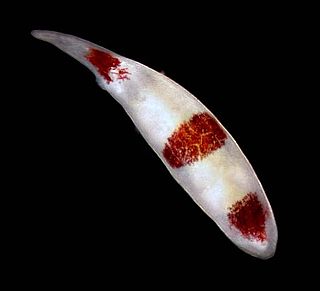
The Prolecithophora are an order consisting of an estimated 300 species of small, active, aquatic flatworms. The order lacks a common English name. Most species are shaped like an elongated, stylized droplet, and are opaque white or yellow; they frequently have contrasting bands or spots in colors, such as purple, yellow, red, or brown. They have no to three pairs of pigment-cup eyes, and well-developed tactile and chemoreceptor senses. With few exceptions, species are protandric hermaphrodites with internal fertilization. Egg capsules are, according to species, glued to various hard surfaces; the young hatch as miniature copies of their parents.

The Lecithoepitheliata are an order of rhabditophoran flatworms. They are free-living worms, found in freshwater, soil, and marine environments.
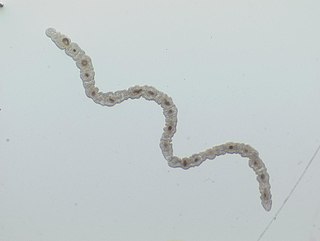
Catenulida is an order of flatworms in the classical classification, or a class of flatworms in a phylogenetic approach. They are relatively small free-living flatworms, inhabiting freshwater and marine environments. There are about 100 species described worldwide, but the simple anatomy makes species distinction problematic.

Continenticola is a clade that includes the land planarians (Geoplanidae) and the freshwater triclads.

Dugesiidae is a family of freshwater planarians distributed worldwide. The type genus is Dugesia Girard, 1850.
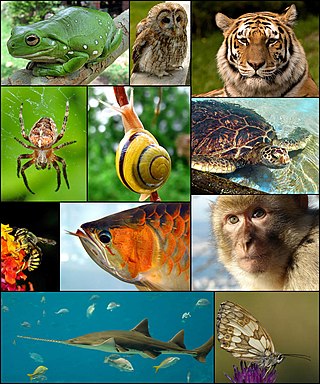
Nephrozoa is a major clade of bilaterians, divided into the protostomes and the deuterostomes, containing almost all animal phyla and over a million extant species. Its sister clade is the Xenacoelomorpha. The Ambulacraria was formerly thought to be sister to the Xenacoelomorpha, forming the Xenambulacraria as basal Deuterostomes, or basal Bilateria invalidating Nephrozoa and Deuterostomes in earlier studies. The coelom, the digestive tract and excretory organs (nephridia), and nerve cords developed in the Nephrozoa. It has been argued that, because protonephridia are only found in protostomes, they cannot be considered a synapomorphy of this group. This would make Nephrozoa an improper name, leaving Eubilateria as this clade's name.

Dimarcusidae is a family of triclads found mostly in freshwater habitats of caves, although at least one species, Rhodax evelinae, occurs in surface waters. Currently the family contains only seven species distributed in five genera, although the total number of species is thought to be much higher.

Neodermata is a clade of rhabditophoran flatworms containing the parasitic groups Trematoda, Monogenea and Cestoda.
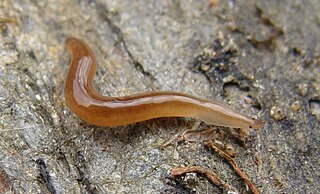
Rhynchodeminae is a subfamily of land planarians with a worldwide distribution.

Caenoplanini is a tribe of land planarians in the subfamily Rhynchodeminae mostly found throughout the Australasian and Oceanian realms.
Rhabditophora is a class of flatworms. It includes all parasitic flatworms and most free-living species that were previously grouped in the now obsolete class Turbellaria. Therefore, it contains the majority of the species in the phylum Platyhelminthes, excluding only the catenulids, to which they appear to be the sister group.

Rhabdocoela is an order of flatworms in the class Rhabditophora with about 1700 species described worldwide. The order was first described in 1831 by Christian Gottfried Ehrenberg. Most of rhabdocoels are free-living organisms, but some live symbiotically with other animals.
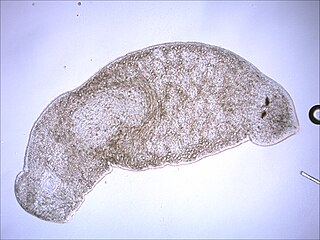
Proseriata is an order of free-living flatworms in the class Rhabditophora with over 400 species described worldwide.
Fecampiida is an order of flatworms in the class Rhabditophora. It is a considerably recent clade, erected after molecular studies.

Trepaxonemata is a subclass of the Platyhelminthes or flatworms. It includes all parasitic flatworms and several free-living species that were previously grouped in the now obsolete class Turbellaria. Therefore, it contains the majority of species in the phylum Platyhelminthes, excluding the Catenulida, and the Macrostomorpha.

Kalyptorhynchia is a suborder of rhabdocoel flatworms. It contains almost 600 species and has a cosmopolitan distribution.
















